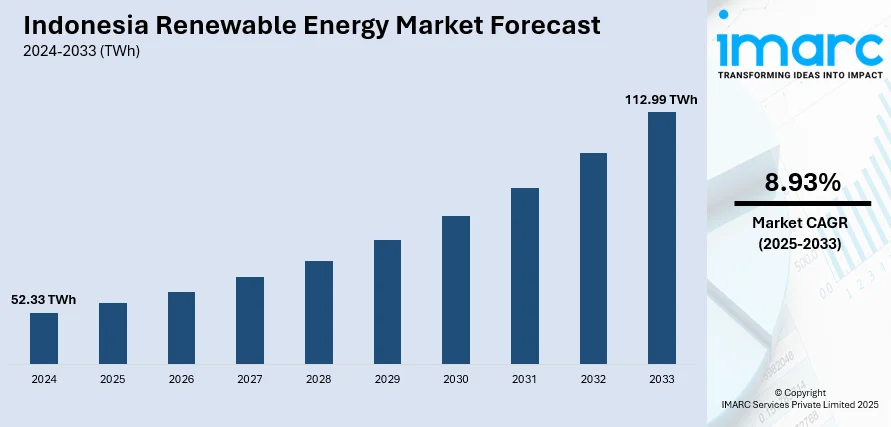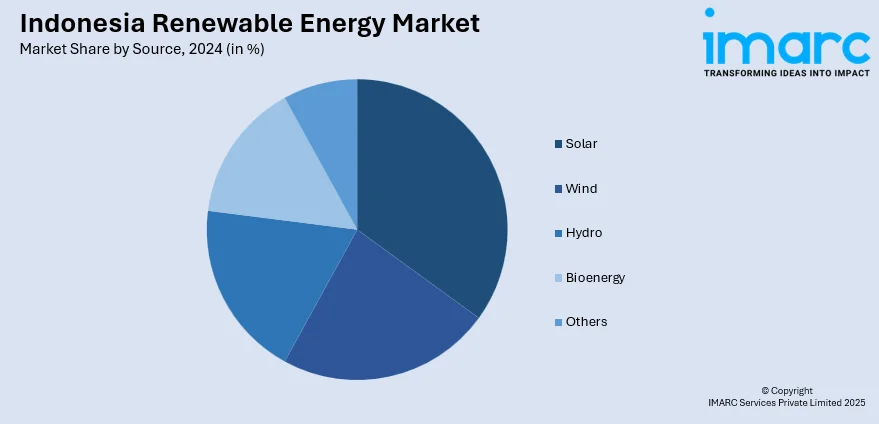
Indonesia Renewable Energy Market Size, Share, Trends and Forecast by Source, and Region, 2025-2033
Market Overview:
Indonesia renewable energy market size reached 52.33 TWh in 2024. Looking forward, IMARC Group expects the market to reach 112.99 TWh by 2033, exhibiting a growth rate (CAGR) of 8.93% during 2025-2033. The growing awareness about climate change, increasing need to reduce greenhouse gas emissions and rising investments in onshore wind projects to maximize wind energy production represent some of the key factors driving the market. This, along with government policies promoting clean energy and abundant natural resources like solar, wind, and geothermal are increasing the overall market share in Indonesia.
|
Report Attribute
|
Key Statistics
|
|---|---|
|
Base Year
|
2024
|
|
Forecast Years
|
2025-2033
|
|
Historical Years
|
2019-2024
|
|
Market Size in 2024
|
52.33 TWh |
|
Market Forecast in 2033
|
112.99 TWh |
| Market Growth Rate 2025-2033 | 8.93% |
Renewable energy is harnessed from sources that naturally replenish themselves. It includes solar, wind, hydroelectric, and geothermal energy and also consists of biomass energy derived from organic materials like wood and crop waste. It is sustainable, as the sources naturally replenish themselves, ensuring a long-term energy supply. It is clean, producing minimal or no air pollution, which helps combat global warming and improve air quality. Renewable energy is often decentralized, enabling local generation and reducing transmission losses. It facilitates the diversification of energy sources and reduction of reliance on fossil fuel imports. It assists in creating jobs, fostering technological innovation, and promoting a more robust and sustainable economy. It also assists in extending energy access to underserved communities and remote regions, improving quality of life. It is used to pump water for irrigation and drinking purposes in rural areas. It is also utilized to power desalination systems to purify seawater, making it suitable for drinking and irrigation. Besides this, it is employed to power street lights, which use photovoltaic panels to generate electricity during the day for illumination at night.

To get more information on this market, Request Sample
Indonesia Renewable Energy Market Trends:
Abundant Natural Resources
Indonesia is rich in renewable energy resources, including solar, wind, geothermal, and hydroelectric potential, which is driving the market growth in the country. In line with this, as one of the world’s most active volcanic regions, Indonesia has significant geothermal reserves, thereby making it a leader in this field. Solar energy is also gaining momentum due to Indonesia’s tropical location, offering high solar irradiance. In addition to this, wind and hydropower resources add to the country’s renewable potential. According to Indonesia renewable energy market analysis, this wealth of natural resources positions Indonesia as an attractive market for renewable energy development, allowing it to diversify its energy mix and reduce its carbon footprint.
Government Policies and Support
The Indonesian government has implemented strong policies to encourage the growth of renewable energy across the country. For instance, in September 2024, the Indonesian government relaxed the local content requirements (LCR) for the development of electricity infrastructure under Ministry of Energy and Mineral Resources regulation with the aim to attract concessional funding for renewable energy projects from international development banks. Indonesia is targeting a renewable energy mix of 23% by 2025, requiring an estimated USD 167 Billion to achieve this goal. The relaxation of LCR is expected to unlock significant foreign investment, which is crucial for meeting these ambitious targets. Additionally, the government’s Renewable Energy Fund supports the development and deployment of green energy technologies. According to Indonesia renewable energy market forecast, this commitment is driven by Indonesia’s aim to reduce its dependency on fossil fuels, improve energy security, and contribute to global climate goals.
Rising Energy Demand and Economic Growth
Indonesia’s rapidly growing population and robust economic development are facilitating the energy demand. As Southeast Asia’s largest economy, Indonesia is experiencing industrial expansion, urbanization, and infrastructure development, all of which require substantial energy supply. Renewable energy is seen as a sustainable solution to meet this rising demand while reducing the environmental impact. The government’s electrification goals for rural and remote areas also encourage renewable energy projects, such as off-grid solar solutions and mini-hydropower plants, to address energy access gaps. Moreover, Indonesia’s long-term economic strategy includes diversifying its energy mix to support stable economic growth and reduce vulnerability to global oil price fluctuations, which, in turn, is driving the Indonesia renewable energy market growth. The increasing awareness of environmental sustainability among businesses and consumers also plays a role, as companies seek to align their operations with green energy practices and reduce carbon emissions, further boosting the demand for renewable energy solutions across sectors.
Indonesia Renewable Energy Market Segmentation:
IMARC Group provides an analysis of the key trends in each segment of the market, along with forecasts at the country level for 2025-2033. Our report has categorized the market based on source.
Source Insights:

- Solar
- Wind
- Hydro
- Bioenergy
- Others
The report has provided a detailed breakup and analysis of the market based on the source. This includes solar, wind, hydro, bioenergy, and others.
Regional Insights:
- Java
- Sumatra
- Kalimantan
- Sulawesi
- Others
The report has also provided a comprehensive analysis of all the major regional markets, which include Java, Sumatra, Kalimantan, Sulawesi, and Others.
Competitive Landscape:
The Indonesia renewable energy market research report has also provided a comprehensive analysis of the competitive landscape in the market. Competitive analysis such as market structure, key player positioning, top winning strategies, competitive dashboard, and company evaluation quadrant has been covered in the report. Also, detailed profiles of all major companies have been provided.
Indonesia Renewable Energy Market News:
- In November 2023, Indonesia launched its investment plan to mobilize $20 Billion in financing pledged by global lenders led by the United States and Japan to accelerate its power sector decarbonization and called for immediate fund disbursement. Under Indonesia's Just Energy Transition Partnership (JETP) the country seeks to cut carbon dioxide emissions to 250 million metric tons for its on-grid power sector by 2030, versus estimated business-as-usual emissions of over 350 million.
- In July 2024, PT PLN (Persero) continued to advance its global collaborations to accelerate the energy transition by expanding the development of new and renewable energy (EBT) -based power plants in Indonesia. This commitment was reinforced at the Green Energy Buyers Dialogue event, organized by the Coordinating Ministry for Maritime Affairs and Investment in Jakarta.
- In August 2024, Barito Renewables announced a partnership with the energy company from the Ayala group, ACEN, to accelerate the development of renewable wind energy projects throughout Indonesia. This collaboration will be carried out through Barito Renewables' subsidiaries, namely PT Barito Wind Energy and ACEN Indonesia Investment Holdings Pte. Ltd.
Indonesia Renewable Energy Market Report Coverage:
| Report Features | Details |
|---|---|
| Base Year of the Analysis | 2024 |
| Historical Period | 2019-2024 |
| Forecast Period | 2025-2033 |
| Units | TWh |
| Scope of the Report | Exploration of Historical Trends and Market Outlook, Industry Catalysts and Challenges, Segment-Wise Historical and Future Market Assessment:
|
| Sources Covered | Solar, Wind, Hydro, Bioenergy, Others |
| Regions Covered | Java, Sumatra, Kalimantan, Sulawesi, Others |
| Customization Scope | 10% Free Customization |
| Post-Sale Analyst Support | 10-12 Weeks |
| Delivery Format | PDF and Excel through Email (We can also provide the editable version of the report in PPT/Word format on special request) |
Key Benefits for Stakeholders:
- IMARC’s industry report offers a comprehensive quantitative analysis of various market segments, historical and current market trends, market forecasts, and dynamics of the Indonesia renewable energy market from 2019-2033.
- The research report provides the latest information on the market drivers, challenges, and opportunities in the Indonesia renewable energy market.
- Porter's five forces analysis assist stakeholders in assessing the impact of new entrants, competitive rivalry, supplier power, buyer power, and the threat of substitution. It helps stakeholders to analyze the level of competition within the Indonesia renewable energy industry and its attractiveness.
- Competitive landscape allows stakeholders to understand their competitive environment and provides an insight into the current positions of key players in the market.
Key Questions Answered in This Report
The Indonesia renewable energy market size reached 52.33 TWh in 2024.
The Indonesia renewable energy market is expected to reach 112.99 TWh by 2033, growing at a CAGR of 8.93% during 2025-2033.
Market growth is fueled by rising electricity demand, government initiatives to reduce dependence on fossil fuels, and increasing investments in clean energy infrastructure. Indonesia’s abundant natural resources—such as geothermal, solar, and hydropower—offer strong potential for renewable energy expansion. The government’s push for sustainability, net-zero carbon targets, and favorable policies like feed-in tariffs and green financing mechanisms are also accelerating adoption.
Need more help?
- Speak to our experienced analysts for insights on the current market scenarios.
- Include additional segments and countries to customize the report as per your requirement.
- Gain an unparalleled competitive advantage in your domain by understanding how to utilize the report and positively impacting your operations and revenue.
- For further assistance, please connect with our analysts.
 Request Customization
Request Customization
 Speak to an Analyst
Speak to an Analyst
 Request Brochure
Request Brochure
 Inquire Before Buying
Inquire Before Buying




.webp)




.webp)












